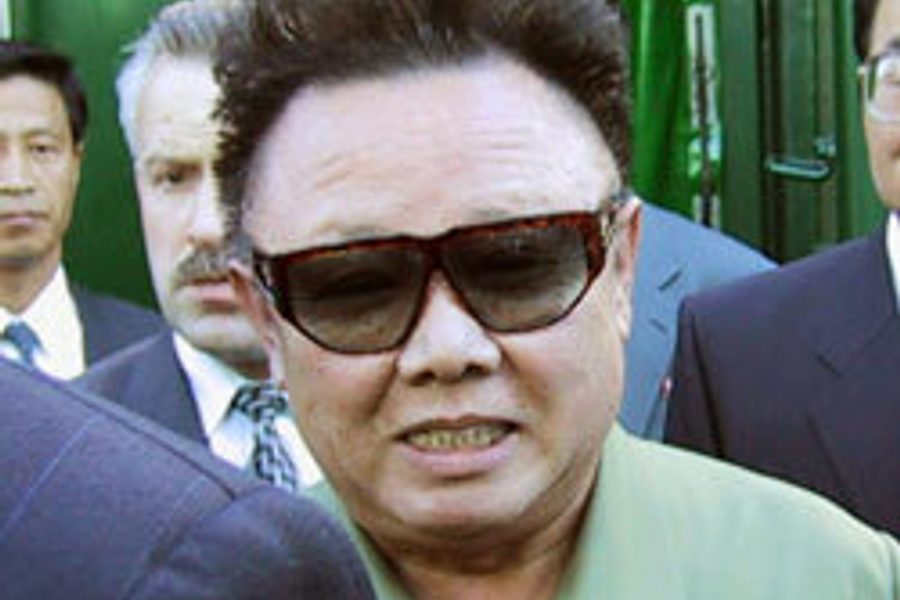
It’s a diplomatic issue, not a military one,” the Bush administration keeps telling the world. The go-slow, wait-and-see approach the United States is taking with North Korea’s nuclear weapons program stands in stark contrast to its aggressive posture toward Iraq. While there may never be a one-size-fits-all approach to dealing with nuclear proliferation, the current crisis in North Korea demonstrates why diplomatic efforts will be far more effective in stopping the new nuclear danger than pre-emptive military strikes.
North Korea’s announced intention to pull out of the Nuclear Non-Proliferation Treaty is only the most recent disturbing action taken by the regime of Kim Jong Il over the past few months. In meetings with U.S. officials in early October, North Korea admitted to secretly continuing its nuclear weapons development program. In January, Pyongyang ordered U.N. inspectors to leave the country and announced plans to reactivate the Yongbyon nuclear facility.
North Korea is thought to have enough weapons-grade plutonium to make one or two bombs. If its nuclear facilities are reactivated, North Korea could produce another five or six nuclear weapons in the next six months. Yet no high-level discussions have taken place between Washington and Pyongyang.
North Korean officials claim their actions are warranted because they are threatened by the United States. To some degree, they have a point. President Bush started his term by breaking off talks with North Korea, pending a full policy review. During that time, the Bush administration paired North Korea with Iraq and Iran in the “axis of evil” and put forward a new nuclear policy with severe implications for Pyongyang.
As part of its “Nuclear Posture Review,” the Pentagon expanded the nuclear hit list to include a wide range of potential adversaries — not just North Korea, but Syria, Libya and Iraq — regardless of whether those nations possess nuclear weapons. The circumstances under which the use of nuclear weapons might be considered also expanded to include retaliation for a North Korean attack on South Korea, or simply as a response to “surprising military developments.” The new Bush doctrine also sanctions the first-use of nuclear weapons to “dissuade adversaries from undertaking military programs or operations that could threaten U.S. interests or those of allies and friends.”
North Korean officials continue to claim that their nuclear activities are for peaceful purposes. Other observers view the situation as a last-ditch effort by Kim Jong Il to force Washington to resume negotiations. North Korea wants engagement, security guarantees and a normalization of relations. As Leon V. Sigal, author of Disarming Strangers: Nuclear Diplomacy with North Korea, notes: “Washington has to understand that Pyongyang is seeking an end to its hostile relationship with the United States. When Washington fails to reciprocate, Pyongyang retaliates.”
At the end of President Clinton’s term, North Korea agreed to extend a moratorium on new ballistic missile tests, began engagement with the South, and expressed a willingness to further restrict or eliminate its nuclear and ballistic missile programs as part of a 1994 Agreed Framework. Instead of picking up where the Clinton administration left off, the Bush administration spent almost two years ignoring and avoiding serious diplomatic initiatives with North Korea.
The Bush administration’s hostile policy has infuriated South Korea, where a number of anti-American protests have been held in recent weeks. President-elect Roh Moo-hyun has urged Washington to continue dialogue and engagement with the North, and to include Seoul in future discussions. The large U.S. military presence is also an issue the new leader expects to take on when in office. Roh Moo-hyun has met with American military officials to discuss a reduction in the 37,000 U.S. troops stationed there.
At the urging of South Korea and other regional allies, Bush recently said that the United States has no hostile intent toward North Korea, and that the situation is “one that can be resolved peacefully, through diplomacy.” For diplomacy to work, there must be a dialogue. The administration appears to have reluctantly acknowledged that threatening pre-emptive military action is a dangerous and limited tool for dealing with regimes seeking to develop nuclear weapons. A diplomatic solution will require getting international inspectors back in the country and negotiations with the United States back on track.
In early January, the International Atomic Energy Association adopted a resolution saying it would give North Korea one more chance to cooperate before referring the matter to the U.N. Security Council. On January 7, the United States, Japan and South Korea issued a joint statement urging North Korea to dismantle its nuclear weapons program. A statement from the U.S. delegation said, “The United States condemns in the strongest possible terms North Korea’s pursuit of nuclear weapons in spite of its Non-Proliferation Treaty commitments.”
However, the United States hasn’t lived up to its own disarmament obligations under the treaty. At the May 2000 review conference on the Non-Proliferation Treaty, the United States and other nations with nuclear weapons pledged to make “an unequivocal undertaking to accomplish the total elimination” of their nuclear arsenals in exchange for the continued commitment of non-nuclear signatories to forswear the development of nuclear armaments. The inability of the United States to eliminate its own huge nuclear arsenal, coupled with its expansion of the role of nuclear weapons in U.S. security policy, is in clear violation of the treaty.
Moreover, if the United States wants to take North Korea to task for its nuclear program, it should be pressing India, Pakistan and Israel to give up their nuclear weapons as well. Instead, Washington rewards those nations with arms sales and military assistance. If the United States expects North Korea to live up to its end of the bargain, the Bush administration must lead the way.





